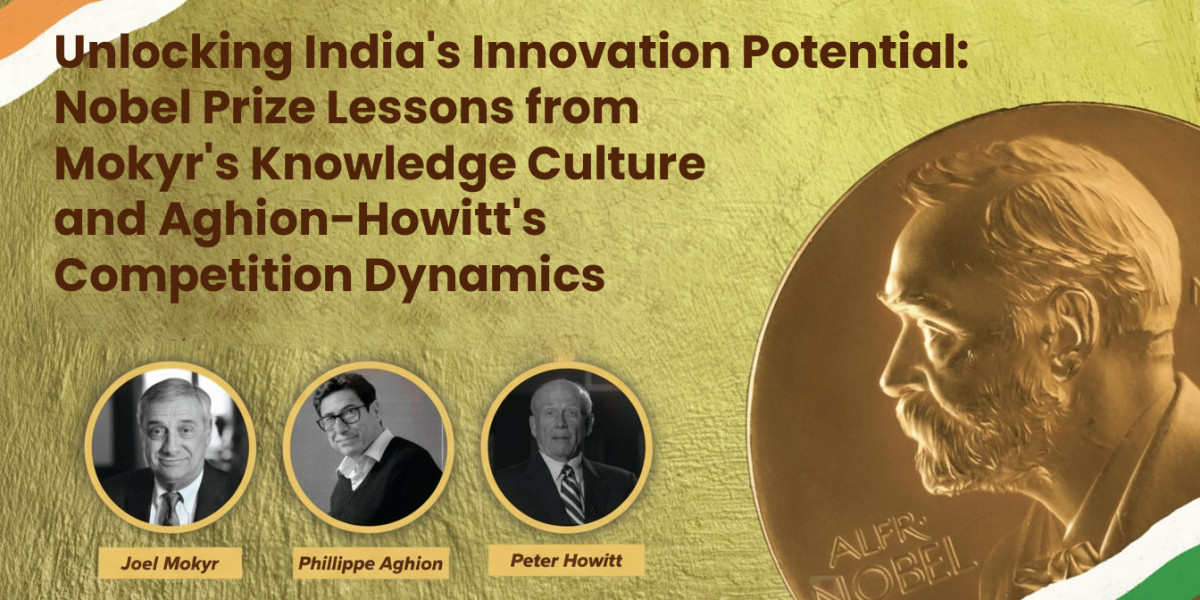The Nobel Framework That Explains India's Innovation Challenge
This year, in 2025, Nobel Prize in Economics awarded to Joel Mokyr, Philippe Aghion, and Peter Howitt represents more than academic recognition-it provides a comprehensive framework for understanding why some nations sustain economic growth while others stagnate. For India, currently ranked 39th in the Global Innovation Index despite being the world's fourth-largest economy, their combined insights offer both diagnosis and prescription.
At its core, the Nobel laureates answer a fundamental question:
How does economic growth begin, and more importantly, how is it sustained?
Mokyr examines the historical origins through the lens of knowledge systems, while Aghion and Howitt model the competitive dynamics that keep innovation alive. Together, they reveal that sustained growth requires both the right cultural infrastructure for knowledge creation and the competitive environment for continuous innovation.
India's economic journey - from the License Raj to liberalization, from IT services hub to aspiring manufacturing powerhouse - provides a compelling real-world laboratory for testing these theories. The nation possesses many ingredients for innovation-driven growth: 118 unicorn startups, a massive talent pool, and improving digital infrastructure. Yet it invests merely 0.64% of GDP in R&D compared to China's 2.4%, the US's 3.47%, and Israel's 5.71%.
This gap isn't merely about money. It reflects deeper institutional and cultural barriers that Mokyr, Aghion, and Howitt's frameworks help us understand.
Mokyr's Knowledge Revolution: Why the Industrial Revolution Started in Europe
The Two Types of Knowledge
Joel Mokyr's central contribution lies in distinguishing between two fundamental forms of knowledge that drive technological progress.
Propositional knowledge means understanding the reason something happens; it's about knowing "why" things work. This includes things like scientific theories, rules of nature, math formulas, or facts you discover. For example, knowing Newton's laws of motion, the periodic table, or how heat works in science are all propositional knowledge.
Prescriptive knowledge is about knowing how to do something; it's the "how" of getting things done. This includes recipes, step-by-step instructions, building designs, or ways to make things. For example, improving the steam engine by using new designs and techniques is prescriptive knowledge.
Mokyr says that lasting economic growth only started when two kinds of knowledge began regularly supporting and building on each other during Europe's Industrial Revolution. Before the 18th century, innovations occurred sporadically - Chinese blast furnaces, Indian wootz steel, Roman aqueducts, Indian Kallanai dam, medieval windmills-but lacked the institutional support for cumulative progress.
The Baconian Revolution and Useful Knowledge
The breakthrough came through what Mokyr calls the "Baconian program," named after 17th-century philosopher Francis Bacon. He argued that knowledge should not only be pursued for its own sake but should also have practical applications that improve the human condition. This philosophical shift transformed Europe's approach to science and technology.
The Enlightenment era institutionalized this vision through organizations like the Royal Society in London and the Académie des Sciences in Paris, which promoted experimentation, peer review, and the public sharing of discoveries.
The Republic of Letters: History's First Open Knowledge Network
Importantly, Europe created what experts call the "Republic of Letters"-a worldwide group of scientists, thinkers, and inventors who shared ideas openly across country lines. This network from the 1600s and 1700s acted like the world's first "open-source" system for knowledge, helping new discoveries spread fast.
Mokyr stresses that Europe's split-up governments turned out to be a hidden strength. Unlike big, single empires such as China or the Ottoman Empire, no one European leader could block unpopular ideas. If a kingdom turned down a scientist's ideas, that person could just move to another area. This setup made countries compete to draw in smart talent and shield creative minds.
Reducing Access Costs to Knowledge
Mokyr uses the term “access costs” to describe how hard it is to find and use existing knowledge. In the Middle Ages, these costs were high because information sat in Latin books, craft guilds hid their secrets, and universities kept to themselves.
During the Enlightenment, people worked to lower these barriers. Research began appearing in journals written in everyday languages, encyclopedias organized practical know-how, new patent laws traded idea-sharing for legal protection, and schools started teaching useful skills to more students.
Once it became cheap and easy to share information, theory and practice fueled each other. Better science - such as thermodynamics - made engines work better, while real-world engine problems pushed scientists to refine the theory. This two-way flow created the first long-lasting burst of economic growth in history.
India Through Mokyr's Framework: The Knowledge Infrastructure Gap
India's Access Cost Problem
Applying Mokyr's framework to contemporary India reveals troubling parallels with pre-Industrial Revolution Europe.
Weak Academia-Industry Linkages: India suffers from a severe disconnect between knowledge creation (universities) and knowledge application (industry). A 2025 study found that Indian universities focus predominantly on theoretical research while businesses seek market-ready solutions, creating what scholars call a "knowing-doing gap." This mirrors the pre-Enlightenment separation of philosophy from practice that Mokyr identified as growth-inhibiting.
The consequences for India's innovation ecosystem are stark. Indian industry invests approximately 0.64% of GDP in R&D (2020-21), significantly lower than 3.46% in the US (2021), 5.21% in South Korea (2022), and 2.9% in the UK (2021). The private sector’s contribution to India’s overall R&D is only 36.4% (2020-21), compared to 76.6% in China (2018) and 75% in the US (2021). These figures are drawn from reports by India’s Department of Science & Technology (DST), the World Bank, OECD, NSF, and the UK’s Office for National Statistics (ONS).
Intellectual Property Challenges: While India has improved patent filings - growing from 42,951 in 2013-14 to 92,168 in 2023-24 - approval rates remain problematic. Patent examinations take an average of 58 months in India versus 21 months in the US. More fundamentally, weak IP enforcement and lengthy litigation deter innovation, functioning as high "access costs" in Mokyr's terminology.
Foreign entities still dominate patent approvals in India (74.46% in 2022), far exceeding China's 12.87%. This suggests India remains primarily a technology consumer rather than creator - exactly the position Europe held before its knowledge revolution.
Brain Drain as Knowledge Exodus: Perhaps most damaging is the outflow of skilled researchers. Between 2015 and 2022, an estimated 1.3 million Indians emigrated, many being doctors, engineers, scientists, and academics. In 2022 alone, 225,000 Indians renounced citizenship to acquire foreign passports.
One-third of IIT graduates move abroad, with India supplying one-fifth of the US STEM workforce. India effectively subsidizes advanced education for foreign economies - estimated at $160 billion annually in lost economic output. In Mokyr's framework, this represents knowledge diffusion in the wrong direction.
Cultural and Institutional Barriers
Mokyr emphasized that beyond formal institutions, culture matters profoundly. Research on India identifies several cultural barriers to innovation that echo Mokyr's concerns:
Intolerance of failure: Indian corporate culture often punishes experimentation, discouraging the risk-taking essential for breakthrough innovation
Hierarchical structures: Top-down decision-making limits researcher autonomy and creativity
Knowing-doing gap: Emphasis on credentials and theoretical knowledge over practical problem-solving
Static view of technology: Perception that technology is something to import rather than develop
These cultural patterns persist despite liberalization reforms, suggesting that dismantling formal License Raj restrictions hasn't fully created the "openness to ideas" Mokyr identified as crucial.
Aghion-Howitt's Creative Destruction: Modeling Innovation-Driven Growth
Formalizing Schumpeter's Insight
While Mokyr explains how growth begins, Philippe Aghion and Peter Howitt tackle how it's sustained. Their seminal 1992 paper transformed economist Joseph Schumpeter's philosophical concept of "creative destruction" into rigorous mathematical models.
Schumpeter observed that capitalism is inherently dynamic - new technologies continuously replace old ones, simultaneously destroying incumbent firms' profits while creating new value. Think of how digital photography obliterated Kodak, smartphones displaced Nokia, or electric vehicles threaten traditional automakers.
The Aghion-Howitt model formalized this process with several key insights:
Innovation as Endogenous: Unlike earlier growth models that treated technological progress as an external factor, Aghion-Howitt showed that firms' strategic R&D decisions drive innovation. Growth becomes endogenous - determined within the economic system rather than falling from the sky.
Quality Ladders and Step-by-Step Innovation: Their model assumes firms must catch up before leaping ahead-innovation happens incrementally on "quality ladders." Each innovation renders previous technologies obsolete while laying groundwork for the next leap.
Temporary Monopoly Profits: Successful innovators earn temporary excess profits through patents or first-mover advantages, compensating for R&D risks. But these profits invite the next innovator to displace them, maintaining competitive pressure.
Business-Stealing Effect: Innovation has dual externalities. It creates social value (positive externality) but destroys competitors' profits (negative externality). This "business-stealing" means subsequent innovators can build on previous work cheaply, but incumbents don't capture the full social benefit of their investment.
The Inverted-U Relationship: Competition's Sweet Spot
Aghion and Howitt found that the link between how much companies compete and how much they innovate looks like an upside-down U shape.
When there is very little competition (like a monopoly), big companies don't feel pressure to improve or invent new things. They are safe and make money easily, so they don't want to spend much on risky research. As a result, new ideas and innovation slow down.
When there is a medium amount of competition, companies are close in skill and technology (they are "neck-and-neck"). Here, each company wants to get ahead, so they work hard to invent and come up with better products. This is when innovation is the highest.
When there is too much competition (lots of companies fighting for survival), it’s very tough to make money from new ideas. Companies that are behind might feel there’s no point in spending money on innovation because catching up is too hard. So, again, innovation slows down.
This inverted-U pattern shows that both "more competition is always better" and "protecting big national companies" are wrong. The best situation for innovation is somewhere in the middle, where companies are pushed to do better but not crushed by too much competition.
The Composition Effect
A subtle but important mechanism Aghion-Howitt identified is the composition effect. Increased competition reduces the fraction of industries that are neck-and-neck (where innovation incentives are strongest) while increasing the share with clear leaders/laggards (where innovation incentives are weaker). This shifts the economy's overall innovation dynamics.
India Through Aghion-Howitt's Framework: The Competition Deficit
License Raj Legacy and Market Concentration
India's economic history provides a textbook case of how inadequate competition stifles innovation. The License Raj (1950s-1991) epitomized the wrong end of the inverted-U curve.
During this era, businesses required government licenses to operate, produce goods, or expand. Up to 80 government agencies had to approve private sector activity. The system created entrenched incumbents insulated from competition, exactly the condition Aghion-Howitt showed minimizes innovation incentives.
As fund manager Maneesh Dangi notes, "If you had invested in the top 20 Indian business groups of the 1960s, more than half would have disappeared by now." Yet this creative destruction happened too slowly-protected firms remained unproductive for decades.
While the 1991 liberalization reforms dismantled formal License Raj restrictions, legacy effects persist:
Inspector Raj: As former RBI Governor Raghuram Rajan observed, "The licence raj is gone, but inspector raj continues." Bureaucratic compliance requirements still burden businesses, particularly SMEs
Regulatory complexity: In 2024 alone, India issued 9,331 regulatory updates that businesses must track
Market concentration: Despite liberalization, several sectors remain dominated by established players with limited competitive pressure
India's Position on the Inverted-U Curve
Current evidence suggests India operates at suboptimal competition levels for innovation across sectors:
Digital markets: The Competition Commission of India's 2024 AI market study warned that tech giants like Google, Amazon, and Microsoft are creating concentrated markets that could stifle innovation. The proposed Digital Competition Act aims to prevent "irreversible tipping" toward permanent dominance.
Manufacturing: India's manufacturing R&D remains weak partly because sectors lack the neck-and-neck rivalry that drives escape-competition effects. Many industries have clear leaders facing limited threats, reducing innovation pressure.
Services: The IT/services sector, where India has succeeded, shows higher competitive dynamics with multiple players competing globally. Not coincidentally, this sector accounts for many of India's 118 unicorns.
Missing the Escape-Competition Effect
Aghion-Howitt's "escape-competition effect"-where neck-and-neck rivals innovate aggressively-requires specific conditions that India often lacks:
Sufficient market size: Firms must see large enough potential rewards to justify R&D investment. India's fragmented markets (partly due to state-level variations) sometimes fail this test.
Effective IP protection: Without confidence they can capture returns, firms won't invest. India's weak enforcement undermines this.
Access to capital: R&D requires patient capital willing to accept risk and delayed returns. India's financial system remains biased toward tangible collateral and short-term lending.
Skilled workforce: Innovation requires specialized talent. Brain drain depletes India's pool of experienced researchers who could lead competitive R&D efforts.
The Synthesis: Why India Needs Both Frameworks
Mokyr Without Aghion-Howitt: Knowledge Without Application
If India focused solely on Mokyr's prescriptions-building research universities, publishing papers, training scientists-without competitive markets to apply discoveries, knowledge would remain theoretical. This is essentially India's current situation: rising PhD enrollments (2.13 lakh in FY22 vs 1.17 lakh in FY15) but weak commercialization.
China's experience illustrates the danger. Despite massive R&D investment (2.4% of GDP), Chinese firms sometimes struggle with genuine breakthrough innovation, partly because state protection shields firms from competitive pressure that would force radical innovation.
Aghion-Howitt Without Mokyr: Competition Without Infrastructure
Conversely, liberalizing markets without building knowledge infrastructure leads to competitiveness in low-innovation sectors. Indian firms might compete fiercely in price or execution but lack the scientific depth for frontier innovation.
This explains India's success in IT services-a sector requiring less fundamental R&D-versus struggles in semiconductors, pharmaceuticals R&D, or advanced manufacturing, which demand deep propositional knowledge.
The Complete Framework Applied to India
The ideas from the three Nobel winners show that India needs to take steps at the same time in different areas.
Reduce access costs: Make it easier to share and use knowledge by building stronger links between universities and companies. This can happen through shared research centers, teachers moving between schools and businesses, and joint funding for projects. The new ₹1 lakh crore RDI scheme is a good step forward, but it must be put into action well to work.
Create a modern "Republic of Letters": Help Indian researchers, business owners, and global knowledge groups work together openly. India's problem of skilled people leaving the country (brain drain) can be fixed with policies that create "brain circulation"—keeping strong ties with Indians who live abroad and bring back ideas.
Improve IP protection: Speed up patent approvals (which now take 58 months in India compared to 21 months in the US) and make enforcement stronger. This will lower the barriers to using knowledge.
Invest in basic research: The government should spend more on core science studies, because private companies won't fully pay for basic knowledge that benefits everyone widely, not just their own profits.
Enhancing Aghion-Howitt's Competitive Dynamics:
Calibrate competition policy: The inverted-U curve suggests policy shouldn't blindly pursue maximum competition. India should identify sectors in the suboptimal zone (too little or too much competition) and adjust accordingly.
In concentrated digital markets, promote entry and prevent anti-competitive conduct
In fragmented sectors, allow consolidation that creates scale for R&D investment
Target the "sweet spot" where neck-and-neck rivalry drives innovation
Support creative destruction's



